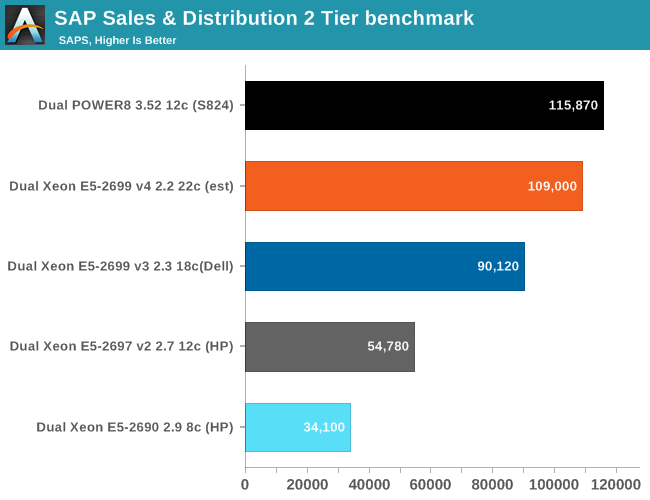The Intel Xeon E5 v4 Review: Testing Broadwell-EP With Demanding Server Workloads
by Johan De Gelas on March 31, 2016 12:30 PM EST- Posted in
- CPUs
- Intel
- Xeon
- Enterprise
- Enterprise CPUs
- Broadwell
SAP S&D
The SAP S&D 2-Tier benchmark has always been one of my favorites. This is probably the most real world benchmark of all the server benchmarks done by the vendors. It is a full-blown application living on top of a heavy relational database. And don't forget that SAP is one of the most successful software companies out there, the market leader of Enterprise Resource Planning.
We analyzed the SAP Benchmark in-depth in one of our earlier articles:
- Very parallel resulting in excellent scaling
- Low to medium IPC, mostly due to "branchy" code
- Somewhat limited by memory bandwidth
- Likes large caches (memory latency)
- Very sensitive to sync ("cache coherency") latency
Let us see how the new Xeon E5 fares in this ERP benchmark.

(est) = Preliminary data
The ever-increasing L3 cache, high core counts, and better NUMA coherency support of Broadwell-EP play well with SAP. It is almost like Intel builds these Xeons for SAP alone. The result is that the current Xeon is no less than 3 times faster than the Xeon 2690 (v1).










112 Comments
View All Comments
jhh - Thursday, March 31, 2016 - link
The article says TSX-NI is supported on the E5, but if one looks at Intel ARK, it say it's not. Do the processors say they support TSX-NI? Or is this another one of the things which will be left for the E7?JohanAnandtech - Friday, April 1, 2016 - link
Intel's official slides say: "supports TSX". All SKUs, no exceptions.Oxford Guy - Thursday, March 31, 2016 - link
Bigger, badder, still obsolete cores.patrickjp93 - Friday, April 1, 2016 - link
Obsolete? Troll.Oxford Guy - Tuesday, April 5, 2016 - link
Unlike you, propagandist, I know what Skylake is.benzosaurus - Thursday, March 31, 2016 - link
"You can replace a dual Xeon 5680 with one Xeon E5-2699 v4 and almost double your performance while halving the CPU power consumption."I mean you can, but you can buy 4 X5680s for a quarter the price of a single E5-2699v4. It takes a lot of power savings to make that worthwhile. The pricing in the server market's always seemed weirdly non-linear to me.
warreo - Friday, April 1, 2016 - link
Presumably, it's not just about TCO. Space is at a premium in a datacenter, and so being able to fit more performance per sq ft also warrants a higher price, just like how notebook parts have historically been more expensive than their desktop equivalents.ShieTar - Friday, April 1, 2016 - link
But you don't get 4 1366-Systems for the price of one 2011-3 System. Depending on your Memory, Storage and Interconnect Needs, even two full Systems based on the Xeon 5680 may cost you more than one system based on the E5-2699 v4. One less Infiniband-Adapter can easily save you 500$ in Hardware.And you are not only halving the CPU power consumption, but also the power consumption of the rest of the system that you no longer use, so instead of 140W you are saving probably at least 200W per System, which can already add up to more than 1k$ in electricity and cooling bills for a 24/7 machine running for 3 years.
And last, but by no means least, less parts means less space, less chance for failure, less maintenance effort. If you happily waste a few hours here or there to maintain your own workstation, you don't do the math, but if you have to pay somebody to do it, salaries matter quickly. With an MTBF for an entire server rarely being much higher than 40.000, and recovery/repair easily taking you a person-day of work, each system generates about 1.7 hours of work per year. Cost of work (it's more than salaries, of course) probably comes up to 100$ for a skilled technical administrator, thus producing another 500$ over 3 years of added operational cost.
And of course, space matters as well. If your data center is filled, it can be more cost effective to replace the old CPUs with new expensive ones, rather than build a new facility to fill with more old Systems.
If you add it all up, I doubt you can get a System with an Xeon 5680 and operate it over 3 years for anything below 20.000$. So going from two 20.000$-Systems to a single 24.000$ Dollar System (because of an extra 4000$ for the big CPU) should save you a lot of money in the long run.
JohanAnandtech - Friday, April 1, 2016 - link
Where do you get your pricing info from? I can not imagine that server vendors still sell X5680s.extide - Friday, April 1, 2016 - link
Yeah, if you go used. No enterprise sysadmin worth his salt is ever going to put used gear that is not in warranty, and in support into production.